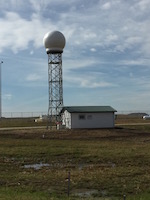NOAA Atmospheric Modification Program
The State of North Dakota through the Atmospheric Resource Board and in association with the National Oceanic and Atmospheric Administration participated in the Federal/State Cooperative Program in Atmospheric Modification Research from its inception in 1980. At its conclusion in 1994, six states participated in the program: Arizona, Illinois, Nevada, North Dakota, Texas, and Utah.
This Federal/State Cooperative Program established a unique, national capability for advancing cloud physics research in atmospheric modification. This capability is considered to be of direct benefit to the nation's ability to understand and manage atmospheric water resources for agriculture, municipalities and industry. The expertise gained in cloud physics for atmospheric modification purposes is also applicable to understanding the role of clouds in global change.
North Dakota's program goals included: investigations of northern Great Plains thunderstorms to study the initiation of ice, the subsequent development of precipitation and hail, and storm turbulence, dynamics, entrainment and electrification.
Toward this end the North Dakota Atmospheric Resource Board coordinated four field research programs funded by the Atmospheric Modification Program and the State of North Dakota. They were: the 1985 and 1987 Field Research Programs in Dickinson, North Dakota, and the 1989 North Dakota Thunderstorm Project, and 1993 North Dakota Tracer Experiment both conducted in Bismarck, North Dakota.
On-site operational research for these programs were conducted in conjunction with and/or supported by the University of North Dakota's Center for Aerospace Sciences, the Institute for Atmospheric Sciences at the South Dakota School of Mines and Technology, NOAA's National Severe Storms Laboratory, Environmental Technologies Laboratory, Wave Propagation Laboratory, and the Cooperative Institute for Research in the Atmosphere at Colorado State University, the National Science Foundation, NASA, and the Canadian Atmospheric Environment Service.

